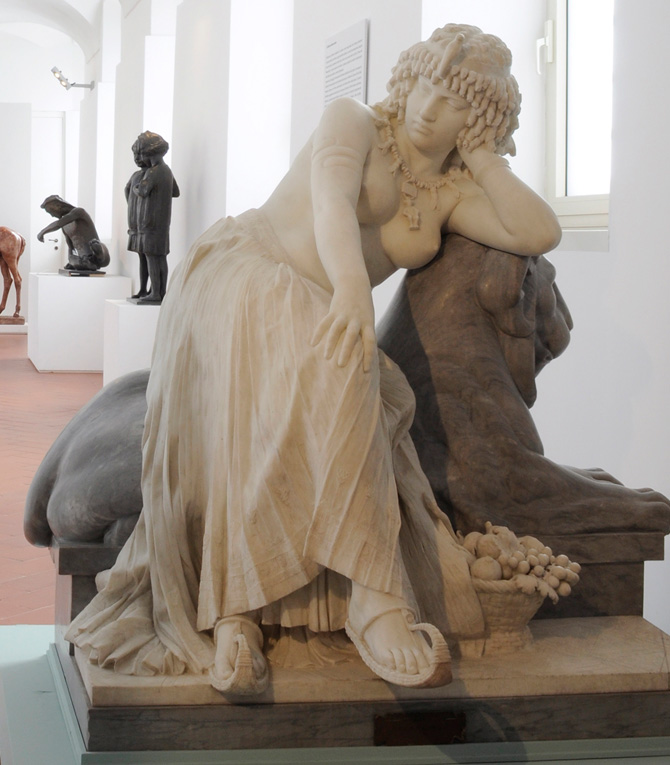The original Lion of Venice 300-200 BCE
"First possibility:
According to one of them, the presence of the Venetians in the Gulf of Alexandretta in the 11th century AD would have enabled them to get in touch with the lion-headed griffin erected by Alexander the Great in memory of those who fell in the battle against Darius III in 333 BC."
 |
| The original lion. First possibility 333 BCE. Monument to Greek casualties in battle against Darius III. |
"Second possibility:
The second possibility would see the lion as part of a monument dedicated to Ishtar, the Babylonian Goddess, erected in Uruk or Babylon in the Seleucid period (4th-1st century BC)."
 |
| The original lion. Second possibility 4th - 1st c. BCE. Monument to Babylonian Goddess, Ishtar. |
"Third possibility:
The third possibility would identify it as a part of a monument dedicated to Sandon, patron deity of the city of Tarsus in Cilicia. We know that up to the 3rd century AD, there was an impressive monument at Tarsus in which Sandon was represented in an upright position on a winged lion. One might therefore assume that the Lion of St. Mark was originally a lion-headed griffin produced during the Early Eastern Hellenistic period between the late 4th and early 3rd century BC."
 |
| The original lion. Third possibility 4th - 3rd c. BCE. Monument to Cilician God, Sandon. |
"In this phase some elements of the statue were recasted and applied again on the body of the lion.
The absence of any sign of the wings suggests that the statue in this era was not winged.
On the side of the lion, traces of a tuft partially chiselled show that in this phase the tail ran along the body. Some details are missing in the area of the head, probably because they were removed as they were no longer in line with the aesthetic and cultural ideals of the period. According to historical sources, Tarsus has been an episcopal seat since the 4th century AD; it is therefore probable that the monument of a Pagan deity was destroyed of which the lion-griffin remained and was then recasted."
 |
| Lion damaged by Christians to conform with Judaic cultural norms. 4th - 6th c. CE. |
"Since the 11th century Venetian merchants frequented the Gulf of Alexandretta and, more generally, the lands of the Eastern Mediterranean; it is therefore likely that during one of their trips they seized the Lion statue. Some feathers arranged on the right side testify to the new and particular role assigned to the lion by the ideology of its new holders, who transformed into the symbol of Mark the Evangelist. It is assumed that during the 12th century, the Venetians seized the statue, which at that time had already been reduced to a simple lion, but it has not yet been established whether its transformation into the symbol of St. Mark happened in Venice or in the East. It is not even known if when the columns were erected, in 1173, the Lion had been already placed in the Piazzetta."
 |
| Venetians loot statue. Partial restoration. 11th c. CE. |
"The first documented information available about the Lion of St. Mark, already located on the column in front of the quay, dates back to this phase. It is about the decision adopted by the Great Council in 1293, when the Venetians decided to adjust (aptari) the Lion. The wings and tail were replaced as well as the right front limb, the shoulders and part of the chest. The iconography of the lion can be identified in many paintings portraying it since the Sixteenth century, such as La flotta Veneziana che si appresta a salpare dal Molo di San Marco contro il Barbarossa by Francesco Bassano the Young, and the Bacino di San Marco e la chiesa di San Giorgio visti dalla Piazzetta of the Canaletto. The wings seem more vibrant and realistic in these paintings rather than in the current ones, with the feathers clearly separated from each other. The most significant parts that date back to this phase and can still be recognized today are the right hind paw, part of the chest and the front right shoulder, and tuft of the tail."
 |
| Venetian modification of statue. 1293 CE. |
"During the Italian campaign, the Republic of Venice was invaded by the troops of Napoleon; with the consequent fall of the Republic, a provisional municipal government was created which provided for the destruction of many of the symbols of Venice, including depictions of the Lion of St. Mark. St. Mark's Treasury was looted, along with the Quadriga of the Basilica and the Lion. The Lion remained in Paris, in front of the Hôtel des Invalides, until 1815 when, during the operations for its removal, it fell and broke into many pieces. Once back in Venice, it was restored and then placed back on the column in the Piazzetta. The sculptor who took charge of the restoration was Bartolomeo Ferrari, who cast new wings using the fragments of the previous ones. The missing parts of the tail and of all paws, except the right hind one, were also integrated by creating an internal frame on which fragments were fixed."
 |
| Damage and partial restoration. 1815 CE. |
Source/Quote:
http://www.meravigliedivenezia.it/en/the-lion/deconstruction-lion/1st-phase-late/first-possibility/index.html


Comments
Post a Comment